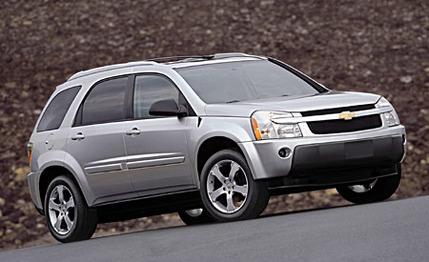 Road Test
Road Test
This doesn't happen often, but in the case of Chevy's new sport-ute, the Equinox, we can boil down its essence to a single, simple word: painless. Perhaps Chevy was hoping for something a little more enthusiastic, like, maybe, fantastic or brilliant. But the Equinox, which doesn't deserve to earn the unfortunate but inevitable nickname "Eek," is not the blood-boiling type, and that's exactly as it should be. Rather, its mission is suburban errand runner, a job where convenience and competence are more appreciated than flair. Considering that, painless is good.
The Equinox is the smallest SUV in Chevy's lineup. It takes the place of the now-discontinued Chevy Tracker, a compact SUV that was a rebadged Suzuki Grand Vitara. The Equinox is also the least expensive, with a base price of $21,560. Our well-equipped test car included four-wheel drive, leather seats, OnStar, and a power driver's seat-all for $28,225.
That sounds pricey for a little truck, but even though Chevy says it's a compact ute, the Equinox is not small. Its 188.8-inch length is about an inch shorter than a Ford Explorer's, and the Equinox rides on a 112.5-inch wheelbase that's only a half-inch less than Chevy's own TrailBlazer's. A Honda CR-V, by comparison, is more than 10 inches shorter than the Equinox.
But somehow the Equinox feels much smaller than the Explorer, probably due to its unibody chassis that is more like a car's than a truck's. The Equinox shares GM's Theta platform with the Saturn Vue. Although the wheelbase was stretched 5.9 inches and the body lengthened by 7.5, the Equinox is a unibody design rather than the separate frame and body of the Explorer and TrailBlazer. Basically, it's a tall car.
Its length advantage over the Vue shows up in rear-seat space, where there's a three-person bench with a one-piece bottom cushion and a 60/40-split backrest with adjustable recline. Like the recently introduced Chevy Malibu Maxx wagon's, the Equinox's rear seat is adjustable fore-and-aft. This is one of those features that makes so much sense you can't believe it's not in every wagon and sport-ute. If you have little kids who need frequent, uh, corrections, or you want to increase rear cargo area, you can slide the seat forward. Or slide it back about eight inches to provide enough legroom for the giants in your house. Another bonus: There are LATCH anchors for three child seats, and they're mounted on the seat frame, so the rear bench can be adjusted without having to remove the kiddy seats.
Cargo volume ranges from 29 to 32 cubic feet, depending on the position of the back bench. Compared with the not-much-longer TrailBlazer, which at 44 cubic feet is nearly the same in space, and the shorter Honda CR-V (34 cubic feet), that seems a little tight. Open the hatch, and you can see why: There are two huge plastic towers that cover the wheel wheels and take up a considerable amount of space. To make up for the loss, there's a movable plastic tray that spans the towers. It has two sides, one carpeted and one bare, and it sits flush in the floor when not in use.
Up front is the dash that every designer at GM should study. We're not talking Audi TT cool here, but it's simple, clean, and highly functional-attributes that don't apply to many GM interiors. The main gauges are a cinch to read at a quick glance, and the radio is at the right height. The manual HVAC controls glide through their motions, and unlike many automatic systems, they don't require a night-school course to operate.
The bucket seats, however, are a little flat, and the optional leather interior feels more like vinyl than cowhide. There's a well-placed center armrest, and plenty of storage pockets are sprinkled throughout.